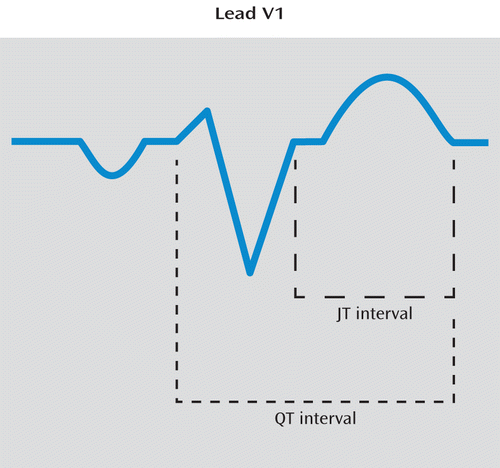Safety of Antipsychotics in the Setting of QTc Prolongation: The Utility of the JT Index
To the Editor: Medication that prolongs cardiac repolarization may increase the risk for re-entrant ventricular arrhythmias, notably torsade de pointes, through the increased variability of heart rate corrected QT interval (QTc), or “QT dispersion” (1). The QTc-prolonging properties of antipsychotics are widely studied, but there are no reports on the appropriate treatment for psychiatric patients with baseline QTc prolongation secondary to left bundle branch block. We report the use of the JT interval, which is calculated as QT-QRS duration (Figure 1), and the JT index (JTI), which is calculated as JT(heart rate+100)/518 in this setting (2).

FIGURE 1. QT and JT Interval Measurements With Left Bundle Branch Block
Case Report
“Mrs. R” is a 77-year-old woman with bipolar disorder, hypothyroidism, coronary artery disease, and known left bundle branch block since at least 2003. From 2003 to 2010, her QTc ranged from 436 to 551 msec. Mrs. R's symptoms had been well controlled on haloperidol (1.5 mg), bupropion (200 mg), and mirtazapine (30 mg). Three weeks before admission to the inpatient psychiatry unit, she experienced command auditory hallucinations telling her to not eat or drink, and she became increasingly depressed and withdrawn, possibly indicating a depressive episode with psychotic features. When she was admitted, her QTc was consistently more than 490 msec, and the team discontinued haloperidol and did not add additional antipsychotics for fear of further QTc prolongation and torsade de pointes. In the absence of any antipsychotic drugs (the patient was taking only citalopram, 40 mg/day), her QTc ranged between 458 and 480 msec. As her QTc prolongation occurred with left bundle branch block and a prolonged QRS duration of 152 msec, we consulted cardiology, calculated her JTI to be normal at 102 (prolonged ≥112 msec), and started treatment with aripiprazole (2.5 mg/day). When this was combined with ECT, her auditory hallucinations diminished. Follow-up ECGs showed increased QTc with a JTI in the normal range. Mrs. R resumed eating and drinking, her functioning returned to baseline levels, and she was discharged.
Discussion
The time-tested QTc is of great value for assessing the risk for ventricular arrhythmias when QTc-prolonging agents (e.g., antipsychotics) are considered (1). However, QTc measures both depolarization and repolarization. In ventricular conduction defects such as left bundle branch block and paced ventricular rhythm, depolarization is increased at baseline and QTc has generally diminished utility (2), although knowledge of baseline QRS and QTc duration may allow cautiously proceeding with QTc-prolonging drug therapy. In practice, however, clinicians feel less comfortable with such an approach, and in these conditions, JTI (which excludes QRS and only measures repolarization) may be more useful in determining the safety of medications that prolong repolarization and increase QT dispersion (3). We do not know if JTI is completely independent of QRS duration (4), and more understanding of this metric will allow for its more widespread application. Further elucidation of the relationship among JTI, QTc, and QRS duration is necessary to avoid undertreating patients with bundle branch block who require antipsychotics.
1. : Antipsychotic drugs: prolonged QTc interval, torsade de pointes, and sudden death. Am J Psychiatry 2001; 158:1774–1782Link, Google Scholar
2. : Should JT interval rather than QT interval be used to detect prolongation of ventricular depolarization? J Electrocardiol 1992; 25:131–136Crossref, Medline, Google Scholar
3. : Prognostic significance of corrected QT and corrected JT interval for incident coronary heart disease in a general population sample stratified by presence or absence of wide QRS complex: the ARIC study with 13 years of follow-up. Circulation 2003; 108:1985–1989Crossref, Medline, Google Scholar
4. : Effects of the ventricular activation sequence on the JT interval. Am J Cardiol 1997; 79:816–819Crossref, Medline, Google Scholar



